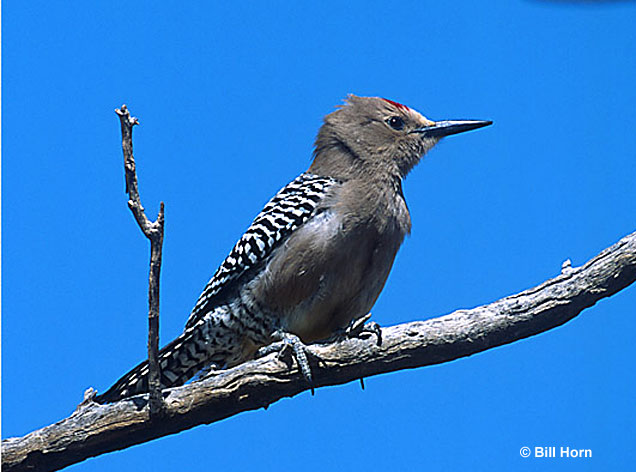The Gila Woodpecker (Melanerpes uropygialis) is a medium-sized woodpecker with a bold, “zebra-striped”, black and white back.
It can be seen around Saguaro cactus and other desert habitats in the southern half of Arizona and some parts of adjacent states. This species is also common in western Mexico.
If you happen to be in the deserts of Arizona and encounter a loud woodpecker with a black and white back, there’s a good chance it’s the Gila Woodpecker. This bold species visits feeders, and isn’t shy about pecking holes in cactus and trees in residential areas.
On this page
Identification
The Gila Woodpecker is a blackbird-sized, pale brown woodpecker with a bold, “zebra-striped”, black and white back. It’s around 9.25 inches long, has a wingspan of 16 inches, and weighs 2.3 ounces.
This woodpecker’s longish wings are finely mottled and striped with black and white markings, it has a barred, black and white rump, and some black barring on its undertail. The Gila Woodpecker also has a bit of yellow on its lower belly.
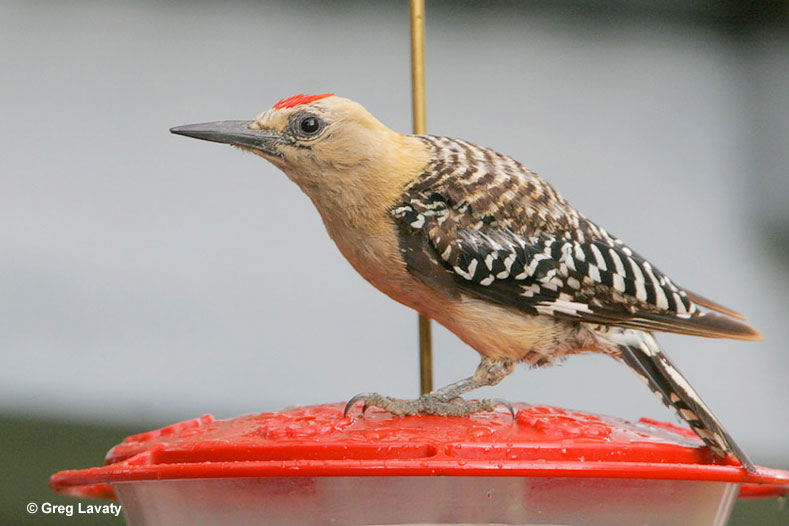
Males and females are very similar, but male Gila Woodpeckers have a small red patch on top of their head. Females lack this patch and have a plain, brown head. Both sexes have a long, black beak, and dark beady eyes on a pale brown face.
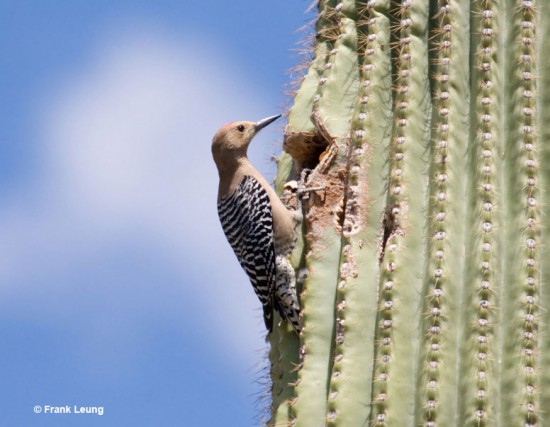
Females do not have a red patch on their heads
They also have a pointed black tail with black and white barring on the central tail feathers.
In flight, Gola Woodpeckers show a small white crescent-shaped patch near their black wingtips. Like other woodpeckers, they fly with a few quick flaps and then hold their wings closed. This makes them look like they are bouncing as they move through the air!
Vocalizations
Gila Woodpeckers often make a loud, rising call, “kweee”. They also make noisy, laughing sound, “keet keet keet keet keet”, and other squeeky and nasal sounding vocalizations.
Food
The Gila Woodpecker is an adaptable species with a wide diet. In general, they eat just about anything they want!
These desert birds mostly feed on insects and small fruit but won’t pass up other feeding opportunities. They love to eat ants, butterflies, moths, beetles, and various other insects.
This woodpecker also commonly eats fruits and flowers of the Saguaro cactus. They sometimes catch small lizards and if they see a bird nest, they might attack it!
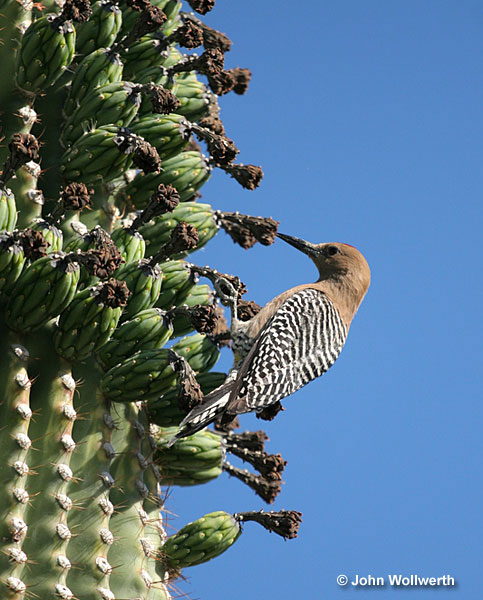
Gila Woodpeckers won’t hesitate to eat the eggs and nestlings of other bird species. Some of the more common birds they prey on are Lucy’s Warblers and Yellow Warblers but they have also been seen killing doves and other birds.
This woodpecker has occasionally caused problems with crops by feeding on corn and pecans. When it visits a feeder, it can take suet and bits of meat!
The Gila Woodpecker forages by moving along the branches and trunks of trees and cacti, and using its bill to snatch prey.
It can pick bugs from vegetation or the ground, and often probes into and taps vegetation.
At certain times of the year, to avoid competition, males feed on larger trunks and branches, and females forage more on dead vegetation and outer branches.
Nesting and Eggs
The Gila Woodpecker nests in a cavity in a tree, Saguaro cactus, or palm. Although many make holes in Saguaros, in riparian zones, they also excavate cavities in Cottonwoods, Mesquite, and other tree species.
Their nest hole can be three feet to twenty feet above the ground, although the average nest cavity is around sixteen feet high.
When they make a nesting hole in a Saguaro cactus, Gila Woodpeckers have to wait several months for the hole to dry out. This might be one of the reasons why this species often reuse the same nest cavity year after year.
This woodpecker usually lays three to five white eggs that are nearly one inch long, and are incubated for around two weeks. Since the nests of this species are difficult to study, nothing is known about the weight of the eggs nor various other aspects of their nesting behavior.
However, it is known that, after hatching, both parents feed the nestlings insects and other food items for four weeks.
When the young leave the nest, they are fed by their parents for several days. Even when they can forage for themselves, the young birds continue to stay with their parents and siblings while the adult birds make a second nest.
Current Situation
Gila Woodpeckers live in deserts and other arid habitats in the southern half of Arizona and parts of adjacent states. They also live in Baja California, and in other parts of western Mexico. We find them in wild desert regions, and, as long as native vegetation is present, in urban and residential areas.
Wherever they occur, this woodpecker species needs a good amount of large cacti and trees for nesting and foraging.
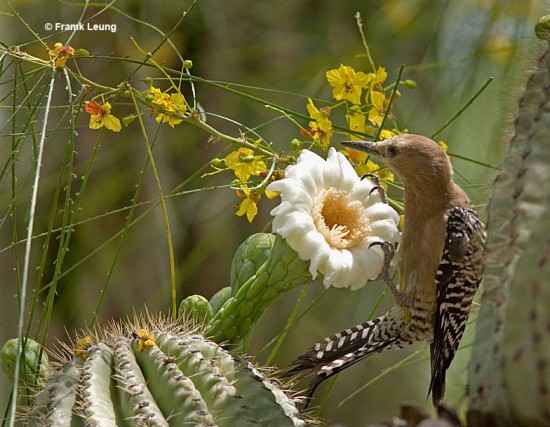
This species is listed as Least Concern in the IUCN Red List.
The Gila Woodpecker is a common bird in much of its range but can be locally threatened by developments that clear Saguaro cacti. It also disappears from places where most trees have been removed. In addition, this woodpecker is threatened by competition over nesting sites with the invasive European Starling.
Facts
- The Gila Woodpecker is named after the Gila River. This tributary of the Colorado River flows from New Mexico west across Arizona to Yuma. It passes through desert and provides habitat for many Gila Woodpeckers.
- Gila Woodpeckers play very important roles for the Saguaro cactus and related desert ecosystems. They help pollinate Saguaros when they feed from their flowers, help spread their seeds when they feed on their fruits, and also provide important nesting and roosting holes for other bird and animal species.
- The Gila Woodpecker is an adaptable bird that takes advantage of any feeding opportunity. These resourceful birds have been seen feeding from hummingbird feeders and eating dog food.
- This species gets nearly all of its water from the foods it eats. Such water sources include flower nectar, the liquid in cactus fruits, and bugs.
Similar Species
The Gila Woodpecker doesn’t live with very many similar species. However, there are a couple other woodpeckers in its range and other similar woodpecker species that live elsewhere.
Related: Types of Woodpeckers in North America
Ladder-backed Woodpecker
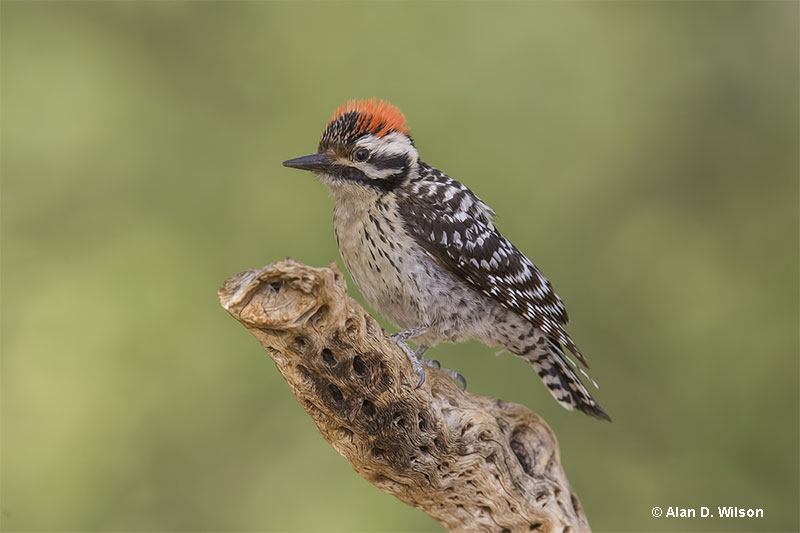
The Ladder-backed Woodpecker is smaller than the Gila Woodpecker. Although it also has black and white barring on its back, this dainty woodpecker has a black and white head, and some dark streaks on its underparts.
Gilded Flicker
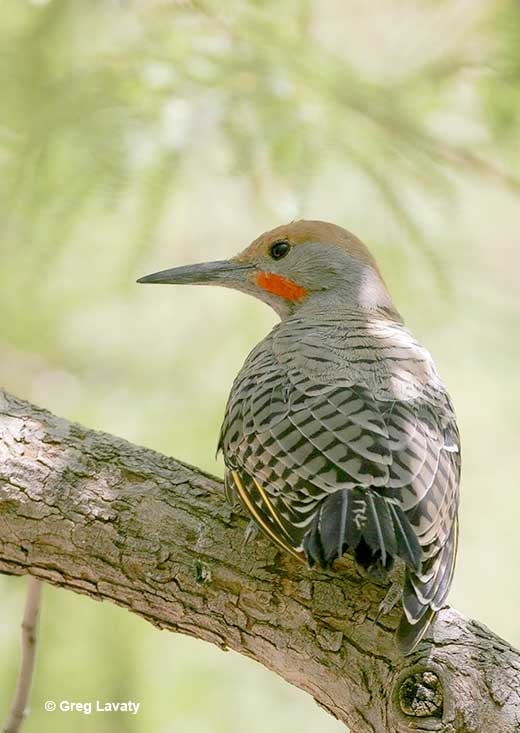
Gilded Flickers have dark barring on a brown back, and a gray head with a brown cap. It also has black markings on buff underparts, yellow wing linings, and a prominent white rump visible in flight.
Golden-fronted Woodpecker
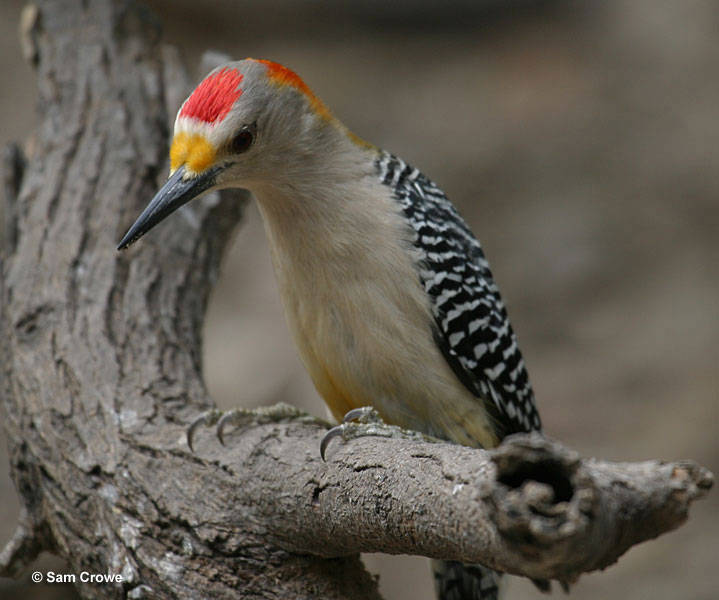
Although similar to the Gila Woodpecker, Golden-fronted Woodpeckers live in Texas and don’t occur with it. The Golden-fronted is also paler below, has orange or yellow on the back of its head, and a white rump.
Red-bellied Woodpecker
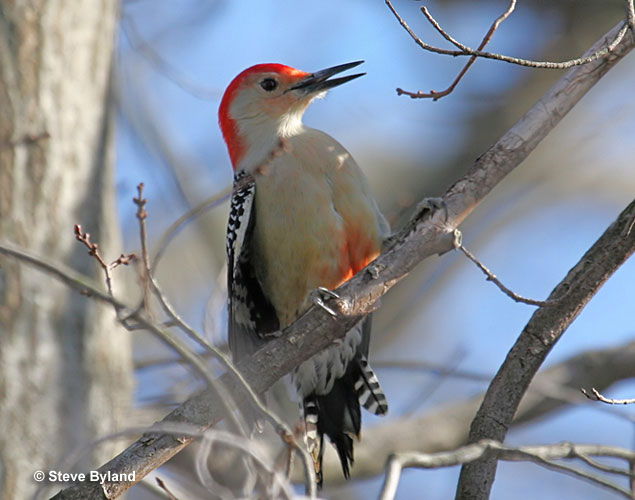
Red-bellied Woodpecker
The Red-bellied Woodpecker lives in eastern North America and doesn’t come close to the range of the Gila Woodpecker. It also has red on the back of its head, and a mostly white rump.
Frequently Asked Questions
What does a Gila Woodpecker do in a cactus?
A Gila Woodpecker excavates nesting holes in cactus. It also feeds on cactus fruit, cactus flowers, and picks insects from the trunk and branches of the cactus.
Where do Gila Woodpeckers live?
Gila Woodpeckers live in arid environments with Saguaro cactus, Mesquite, and other desert vegetation. They range from Arizona to western Mexico.
Why are Gila Woodpeckers endangered?
Gila Woodpeckers are not endangered. However, they can be locally threatened by clearing of Saguaro cactus and destruction of other desert habitats.
Why are Gila Woodpeckers important?
Gila Woodpeckers are important because they play important roles in the desert ecosystems of Arizona. They help pollinate and spread seeds for Saguaro cactus. The bold colors and character of this species also make it an important symbol for the Sonoran Desert ecosystem.

